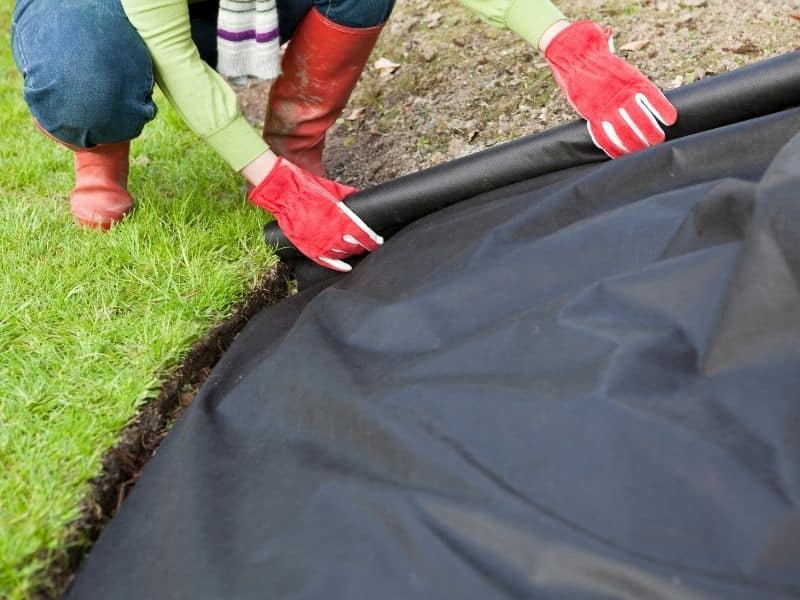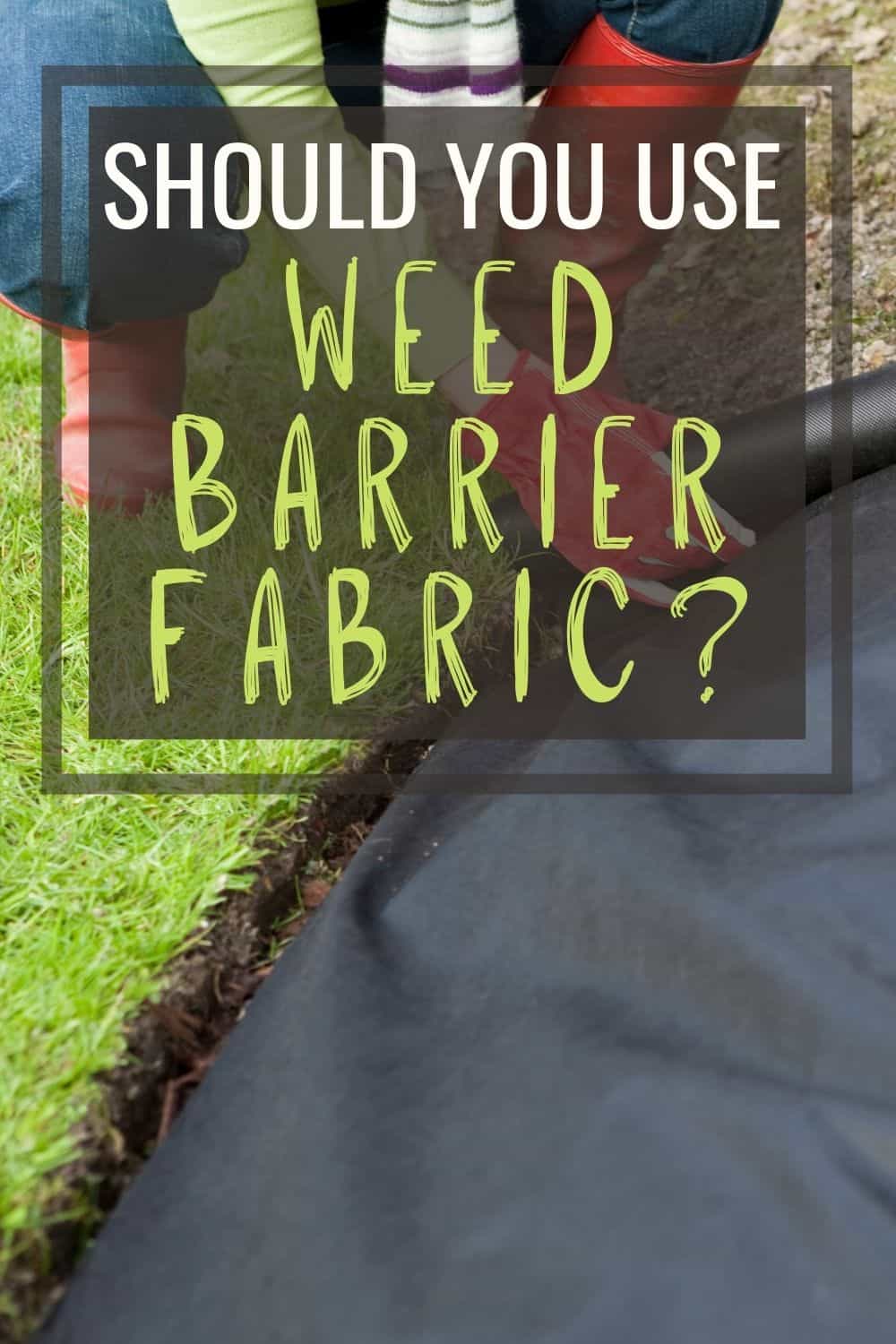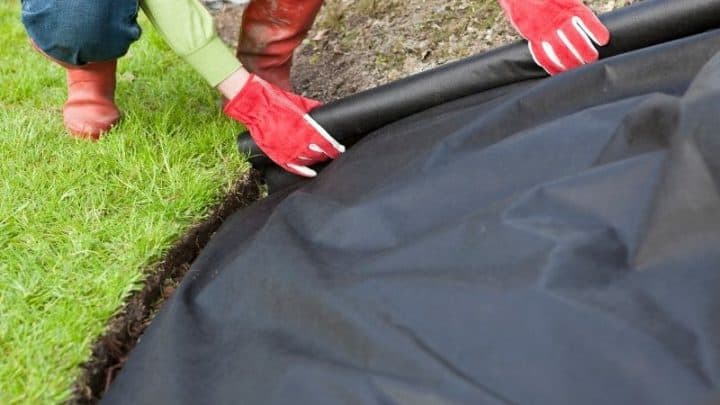The prospect of laying down plastic ground cover and then not having to weed all summer sounds too good to be true. So is it? As with many things, it depends. This article will cover when and how to use weed barrier fabric for optimum results, as well as the best weed barrier fabric to choose for your situation.

First, what is weed barrier fabric? A weed barrier is a piece of material – usually polyester or polypropylene – that inhibits weed growth by preventing sunlight from penetrating the soil and physically blocking plant growth. While some are made of solid plastic, others allow air and moisture to pass through.
By reducing weeds, a good weed barrier fabric also reduces back and joint strain from pulling weeds and frees up your time for more enjoyable tasks. Plus, it eliminates the need for toxic herbicides.
Tips for Best Weed Barrier Fabric Use
Weed barrier fabric is often used in beds or paths and in flower gardens, vegetable gardens, greenhouses, or general landscaping. In most cases, it is held down by landscape staples and covered by mulch or other material both to protect the fabric and to prevent runoff.
Keep in mind that this makes weed barrier fabric hard to move once put into place, and removing or adding plants can be difficult as well. So with the exception of vegetable gardens, it should not be used with annuals.
Even the most durable weed barrier will break down over time and need to be replaced, whether in two years or 12.
Toward the end of this lifespan, weeds can sprout in the mulch or poke up through holes that inevitably form and become hopelessly entangled in the fabric. Plus, the fabric itself may work its way up through the mulch to wave its frayed edges unenticingly, and bits of plastic will, regardless, end up in the soil and elsewhere.
This is starting to sound like more trouble than it’s worth! However, weed barriers do have their place, and they can be enormously helpful when used properly.
Landscape weed barrier fabric
In landscaping, weed barrier fabric is best used where there are no plants, as in addition to the problems above, it can reduce or eliminate the movement of moisture, nutrients, and air and cause soil compaction.
Use it to line walkways, under rock mulch, or to help stabilize soil behind a retaining wall. It can also be used around permanent trees and shrubs, though of course, that is not ideal.
Regardless of the application, choose a durable, quality weed barrier fabric proven to last many years, such as a commercial-grade weed barrier fabric. Steer clear of those that easily degrade (unless, of course, they’re designed to be biodegradable), and opt for permeable material over solid plastic sheeting.
Vegetable garden weed barrier fabric
Vegetable gardeners use weed barrier fabric to line the bottom of raised beds, suppress weeds in paths, and cover beds during the growing season as a kind of “mulch.” Weed barriers can also be laid out in the early spring to help warm the soil and kill weeds, then be pulled up before planting.
This last, called occultation, is my favorite option, as it limits the amount of time the plastic is out in the open, thus lengthening the lifespan of the weed barrier and reducing plastic waste. All you have to do is lay out sheets of black, UV-treated plastic over the growing area, weigh them down with bricks, sandbags, or hay or straw bales, and then wait for at least three to four weeks.
During this time, warmth from the sun combined with moisture trapped under the plastic will encourage weed seeds to germinate and sprout, but the lack of sunlight then causes them to wither and die. When you remove the plastic, you will have a warm, weed-free seedbed ready for sowing: no machinery or herbicides required!
Selecting the Best Weed Barrier Fabric
First, let’s look at the permeability of the weed barrier fabric. Though woven material will perform best in most applications, some situations call for solid plastic, as in the occultation process described above.
Solid plastic sheeting, or “plastic mulch,” restricts air and water movement as well as sunlight penetration. This can be detrimental to trees, shrubs, and other perennial landscaping plants and will contribute to soil compaction when left in place for multiple years.
Therefore, plastic sheeting is not typically recommended for general home use. In a vegetable garden, however, it can give plants a head start by warming the soil faster in the spring, reduce insect pests, and increase crop yields.
Woven or punched landscape fabric, on the other hand, allows for the circulation of air and moisture, making it a better choice for perennial beds and other long-term use.
As an added bonus, biodegradable weed barriers will naturally break down over time, reducing plastic waste both in the garden and in the landfill and saving you the work of digging it up when it needs to be replaced. Note that these come in both permeable and solid types — more on this in the sustainable section below.
Although your local hardware store likely has some good options, here are a few popular weed barriers to give you an idea of what to look for.
ECOgardener 5oz premium pro garden weed barrier landscape fabric
A top seller on Amazon, ECOgardener’s professional-grade landscape fabric is clearly one of the most popular weed barriers.
- It features a five-ounce, professional-grade, heavy-duty fabric for long-lasting weed control.
- In addition, its needle-punched design allows both air and water to pass through.
- It is easy to cut, with thick backing that prevents fraying, and has vertical stripes that act as handy guides in creating straight edges.
Some evidence has shown that prolonged exposure to heat and strong sunlight may cause the fabric to degrade, so make sure to keep it out of direct sunlight and to cover it up promptly after installation.
And despite the name of the company, the product itself – made from “100% new polypropylene material,” according to the package – does not appear to be eco-friendly.
Agfabric landscape ground cover
This durable yet permeable woven plastic landscape ground cover is treated against UV damage for longer-lasting weed protection. Row lines make orderly planting or creating neat edges easy, or you can opt for a similar Agfabric weed barrier that comes with convenient precut planting holes; just make sure they match your desired spacing.
Although puncture- and tear-resistant, the fabric does, unfortunately, tend to fray significantly once cut. To prevent this, simply fold cut edges under before putting landscape staples in place, or melt them.
The heavy-duty fabric can also be difficult to cut, so make sure you have a strong, sharp knife or pair of scissors to do the job.
DeWitt 12-year weed barrier fabric
With a three-ply design and UV treatment, the DeWitt 12-year weed barrier fabric should last for more than a decade, according to the company, and a slew of five-star reviews appear to back up this claim to quality.
Despite its durability and enhanced light-blocking design, this fabric is also hydrophilic treated for improved nutrient and water flow. And thanks to its spun-bond design, it doesn’t fray when cut.
The fabric’s thickness, though a huge advantage overall, can make it difficult to cut, and you’ll want some heavy-duty landscape staples to secure it. Water also might take some time to seep through despite the hydrophilic coating.
DeWitt Sunbelt ground cover weed barrier
Another option from DeWitt, the sunbelt ground cover weed barrier is a favorite among market gardeners. The woven black polypropylene allows movement of air and water yet resists tears and punctures, and yellow guide strips help align plants in straight rows.
In addition to gardens, it works well in nurseries and greenhouses. The company guarantees that the material will last for five years in direct sunlight, thanks to its UV treatment.
Although easy to cut, this weed barrier fabric will fray, so reviewers recommend creating planting holes with a hot knife or a torch.
Sustainable weed barrier options
If the thought of putting plastic in your garden makes you gag, there are some excellent sustainable options available, from biodegradable weed barrier fabric to DIY approaches. In many cases, a good thick layer of disease- and weed-free mulch will significantly reduce weed growth while also regulating moisture and contributing organic matter to the soil.
A favorite trick of many vegetable gardeners is to use cardboard or newspaper for weed suppression. In my garden, I laid down overlapping sheets of cardboard (stickers, tape, and staples carefully removed) in the paths and covered it with bark mulch. The more you overlap the cardboard, the better the weed protection. It also helps to remove rather than simply cover up weeds, though of course, you can also try occultation.
Since newspaper breaks down faster, it’s not always the best option for paths, but some people like to put it around plants. I find that a thick layer of old hay does the trick in the vegetable beds, though it may need to be replenished once or twice if the vegetables don’t eventually shade out the weeds (bush beans are pretty good at this).
However, the newspaper can be a good option if you’re looking for a bit of added protection under the mulch in flower beds.
There are also some decent sustainable weed barrier products on the market if you would prefer to go that route. Here are a few options to get you started.
Bio360
Both biodegradable and toxin-free, Bio 360 is a plant-based bioplastic alternative to traditional black plastic weed barriers. It’s designed to slowly biodegrade in the garden, providing weed protection yet almost completely disappearing in four to six months, so that it can be incorporated into the soil at the end of the season.
Biodegradable mulch film will get a bit messy toward the end of the season as it breaks down and pieces blow around and potentially stick to produce. It also obviously is not reusable, which means you will have to repurchase it every year.
BioTELO
Another biodegradable mulch film, BioTELO lasts for one-and-a-half to four-and-a-half months. It’s made from corn starch, making it environmentally friendly while retaining the same resistance, elasticity, and mulching efficiency as conventional plastic mulch.
As with Bio306, BioTELO can get both messy and expensive, but if you can afford it, the tradeoff just might be worth it.
WeedBlock biodegradable mulch
Chemical-free and made from recycled paper, WeedBlock mulch is OMRI Listed for organic gardening. This thick, absorbent paper mulch not only suppresses weeds but also helps conserve moisture while still allowing the flow of air and water. Of course, being paper, it will break down over the course of a season and can be worked into the soil in the fall or the following spring.
Although relatively strong for paper, WeedBlock will still tear fairly easily, so care should be taken during installation. It also should be weighted down rather than pinned with landscape staples, which may not hold it sufficiently.
Rethink garden weed barrier fabric
Before investing in a potentially time-saving product, it’s always important to first confirm that it won’t actually just cause a big headache. In the case of weed barriers, the effectiveness just depends on proper selection and application. As you’ve seen, when used the right way, weed barriers perform as expected, preventing weeds and sometimes providing other benefits besides.









